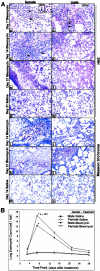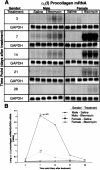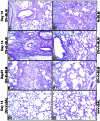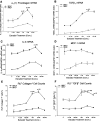Gender-based differences in bleomycin-induced pulmonary fibrosis
- PMID: 15920145
- PMCID: PMC1602429
- DOI: 10.1016/S0002-9440(10)62470-4
Gender-based differences in bleomycin-induced pulmonary fibrosis
Abstract
The role of gender and sex hormones is unclear in host response to lung injury, inflammation, and fibrosis. To examine gender influence on pulmonary fibrosis, male and female rats were given endotracheal injections of either saline or bleomycin. Female rats showed higher mortality rates and more severe fibrosis than did male rats, as indicated by higher levels of lung collagen deposition and fibrogenic cytokine expression. To clarify the potential role of female sex hormones in lung fibrosis, female rats were ovariectomized and treated with either estradiol or vehicle plus endotracheal injections of either saline or bleomycin. The results showed diminished fibrosis in the ovariectomized, bleomycin-treated rats without hormone replacement. Estradiol replacement restored the fibrotic response to that of the intact female mice in terms of lung collagen deposition and cytokine expression, which was accompanied by higher plasma estradiol levels. Furthermore, fibroblasts from bleomycin-treated rats exhibited increased responsiveness to estradiol treatment, causing dose-dependent increases in procollagen 1 and transforming growth factor-beta1 mRNA expression relative to untreated controls. Taken together these findings suggest that female mice may have an exaggerated response to lung injury relative to male mice because of female sex hormones, which have direct fibrogenic activity on lung fibroblasts. This may provide a mechanism for a hormonally mediated intensification of pulmonary fibrosis.
Figures








Similar articles
-
[Effects of andrographolide on the concentration of cytokines in BALF and the expressions of type I and III collagen mRNA in lung tissue in bleomycin-induced rat pulmonary fibrosis].Xi Bao Yu Fen Zi Mian Yi Xue Za Zhi. 2011 Jul;27(7):725-9. Xi Bao Yu Fen Zi Mian Yi Xue Za Zhi. 2011. PMID: 21722520 Chinese.
-
Short courses of low dose dexamethasone delay bleomycin-induced lung fibrosis in rats.Eur J Pharmacol. 2006 May 1;536(3):287-95. doi: 10.1016/j.ejphar.2006.03.011. Epub 2006 Mar 14. Eur J Pharmacol. 2006. PMID: 16581064
-
In situ hybridization analysis of rat lung alpha 1(I) and alpha 2(I) collagen gene expression in pulmonary fibrosis induced by endotracheal bleomycin injection.Lab Invest. 1994 Feb;70(2):192-202. Lab Invest. 1994. PMID: 7511187
-
Perspective article: transforming growth factor-beta: crossroad of glucocorticoid and bleomycin regulation of collagen synthesis in lung fibroblasts.Wound Repair Regen. 1999 May-Jun;7(3):133-40. doi: 10.1046/j.1524-475x.1999.00133.x. Wound Repair Regen. 1999. PMID: 10417748 Review.
-
Pulmonary toxicity of antitumor agents.Cancer Treat Rev. 1983 Dec;10(4):221-43. doi: 10.1016/0305-7372(83)90012-9. Cancer Treat Rev. 1983. PMID: 6198083 Review. No abstract available.
Cited by
-
Estradiol promotes the development of a fibrotic phenotype and is increased in the serum of patients with systemic sclerosis.Arthritis Res Ther. 2013 Jan 10;15(1):R10. doi: 10.1186/ar4140. Arthritis Res Ther. 2013. PMID: 23305385 Free PMC article.
-
Changes in lung sialidases in male and female mice after bleomycin aspiration.Exp Lung Res. 2022 Nov-Dec;48(9-10):291-304. doi: 10.1080/01902148.2022.2144548. Epub 2022 Nov 16. Exp Lung Res. 2022. PMID: 36382835 Free PMC article.
-
A mouse model of chronic idiopathic pulmonary fibrosis.Physiol Rep. 2014 Feb 25;2(2):e00249. doi: 10.1002/phy2.249. eCollection 2014 Feb 1. Physiol Rep. 2014. PMID: 24744912 Free PMC article.
-
Intracellular hydroxyproline imprinting following resolution of bleomycin-induced pulmonary fibrosis.Eur Respir J. 2022 May 5;59(5):2100864. doi: 10.1183/13993003.00864-2021. Print 2022 May. Eur Respir J. 2022. PMID: 34561295 Free PMC article.
-
Effect of Sex Differences in Silicotic Mice.Int J Mol Sci. 2022 Nov 17;23(22):14203. doi: 10.3390/ijms232214203. Int J Mol Sci. 2022. PMID: 36430681 Free PMC article.
References
-
- Hiwatari N, Shimura S, Sasaki T, Aikawa T, Ando Y, Ishihara H, Seskizawa K, Sasakima H, Takishima T. Prognosis of idiopathic pulmonary fibrosis in patients with mucous hypersecretion. Am Rev Respir Dis. 1991;143:182–185. - PubMed
-
- Mannino DM, Etzel RA, Parrish RG. Pulmonary fibrosis deaths in the United States, 1979–1991; an analysis of multiple-cause mortality data. Am J Respir Crit Care Med. 1996;153:1548–1552. - PubMed
-
- Gross TJ, Hunninghake GW. Idiopathic pulmonary fibrosis. N Engl J Med. 2001;345:517–525. - PubMed
-
- Piguet PF, Collart MA, Grau GE, Sappino AP, Vassalli P. Requirement of tumor necrosis factor for development of silica-induced pulmonary fibrosis. Nature. 1990;344:245–247. - PubMed
-
- Gharaee-Kermani M, Phan SH. Role of cytokines and cytokine therapy in wound healing and fibrotic diseases. Curr Pharm Dis. 2001;7:1083–1103. - PubMed
Publication types
MeSH terms
Substances
Grants and funding
LinkOut - more resources
Full Text Sources
Medical

